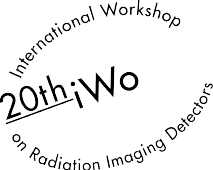Speaker
Description
For the dose distribution verification in robotic radiosurgery which is one of stereotactic radiosurgery (SRS), X-ray films are used due to their high sensitivity uniformity and resolution. Two-dimensional (2-D) Al2O3 thermoluminescence dosimeters (TLDs) are reusable 2-D passive detectors with good TL properties [1]. Previous study has suggested that the 2-D Al2O3 TLDs had high applicability for quality assurance of robotic radiosurgery [2]. However, the influences of energy dependences for the Al2O3 TLDs in robotic radiosurgery are unknown. In robotic radiosurgery, energy spectrums of photons vary in accordance with the field size, source-to-axis distance (SAD) and depth in water. TL efficiencies also vary in accordance with energy spectrums of photons. For this reason, it is important to characterize energy dependences of the Al2O3 TLD for the verification of the 2-D dose distribution in robotic radiosurgery. In this study, we investigated the energy dependences on the field size, SAD and depth in water in robotic radiosurgery.
The 2-D Al2O3 TLDs were composed of Al2O3 (>99.5 wt%) doped with 0.05 wt% Cr2O3. The effective atomic number and bulk density was 11.14 and 3.7 g/cm3 respectively. The 63×63×0.7 mm3 Al2O3 TLDs were irradiated with 6 MV X-ray beams from CyberKnife®, which is an only robotic radiosurgery system, and then read out with a dedicated 2-D TL reader. The TL reader consists of a hot plate and a sensitive complementary metal-oxide-semiconductor (CMOS) camera with a heat absorption filter.
For the field size dependence, an Al2O3 TLD was set at a depth of 15 mm and with three constant SADs. The diameters of irradiation fields were 5, 10, 20, 40 and 60 mm. This geometry was the same as the measurement geometry of output factors. The SADs were 650, 800 and 1000 mm. For the depth dependence, an Al2O3 TLD was set at six depths with a constant SAD of 800 mm. The depths in water were 0, 15, 50, 100, 200 and 300 mm. The diameters of irradiation fields were same as them in the measurement for the field size dependence.
The TL response to the reference value by the semiconductor detector decreases as the field size decreases. This is because the mean energy of photon increases as the field size decreases. At the field size of 5 mm in diameter, the field size dependence was some 5%. There are small changes of field size dependences by different SADs. The TL response to the reference value decreases as the depth in water increases because of the beam hardening effect. Therefore, when applying the 2-D Al2O3 TLD to the absolute dose verification, we should use care about the energy dependences of it.




